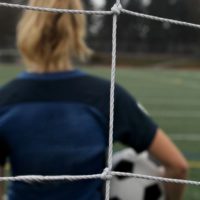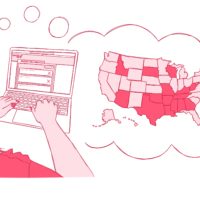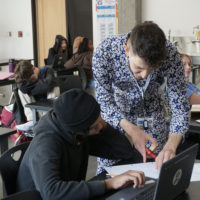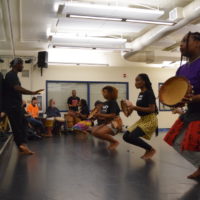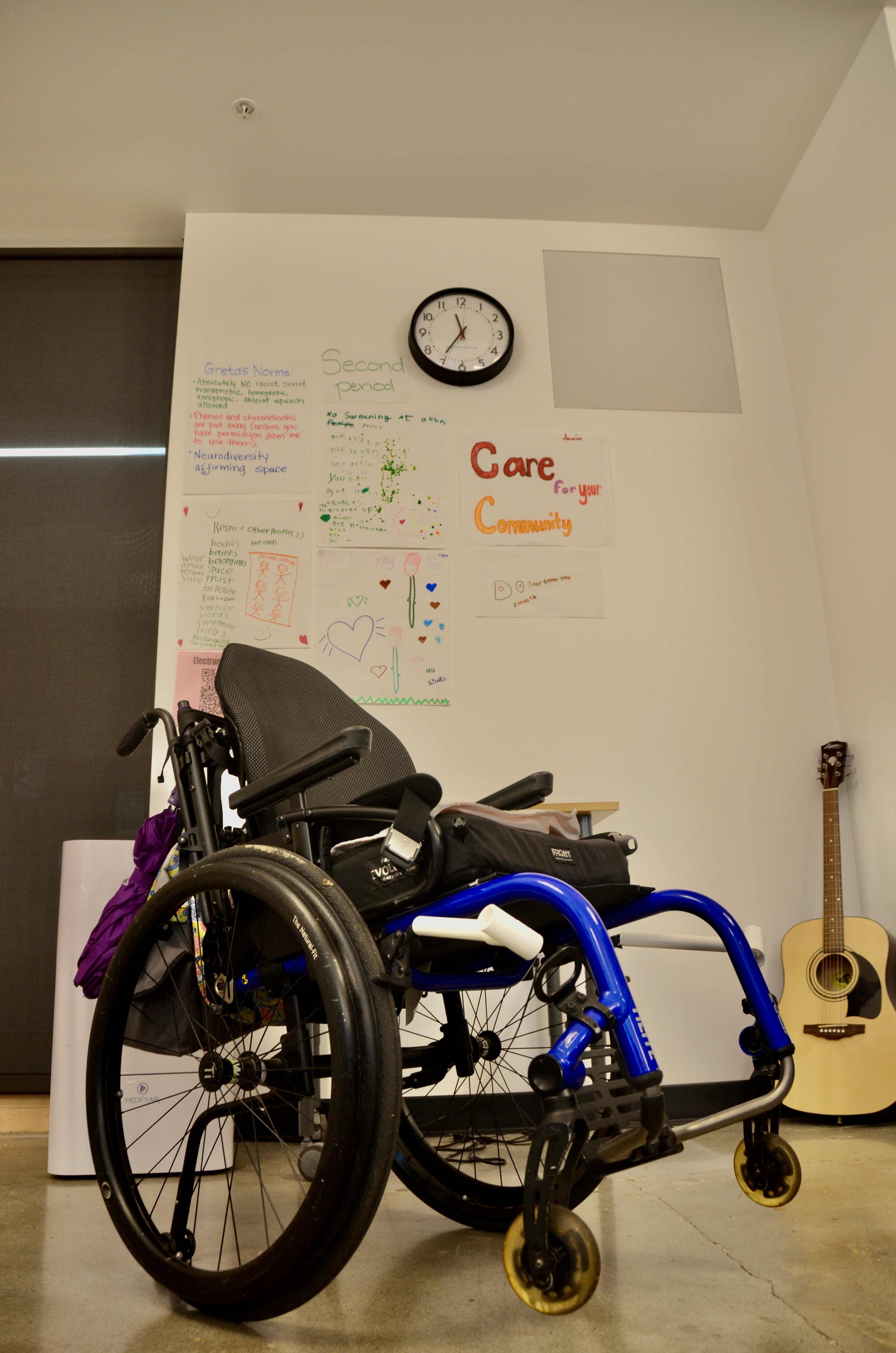
All students receiving special education services that are quoted in this story are kept anonymous in compliance with Title IX and the Family Education Rights and Privacy Act.
Surrounded by warm orange light, a crowd clusters around a table. Students work together to fill sugar skull molds with sugar, each helping to hold the spoon or the mold. A sense of community is palpable in the space. A guiding hand is placed on an elbow. Voices are low and kind. There’s support – visible and tangible in the accessible arrangement of the classroom and the calm voices of encouragement.
The inclusion in Grant’s Intensive Skills Center is evident. Unfortunately, this access is not reflected within the rest of Portland Public Schools (PPS).
Throughout PPS, special education is understaffed and underfunded. This severe lack of support means that students’ needs are not being met.
“Right now the number one challenge is staffing,” says Grant Special Education teacher Ashlee Brooks, “And the number two challenge is access to administrative support. And those two things are preventing access to inclusion on this campus for students with disabilities.”
“It is not uncommon for us to be short-staffed,” Brooks continues. The current challenges facing Grant’s Special Education Department reflect a long history of discrimination against people experiencing disability.
Disability, as a concept, has long been weaponized as a tool for discrimination. In America, pseudosciences such as “drapetomania” were used by white 18th-century scientists to justify slavery. Post-emancipation, labels of disability continued to be used to alienate people and justify discrimination, rather than giving individuals the support that they deserve.
“What happened during that time is that white folks said ‘well, here’s what it means to be smart,’” says disability justice advocate Talila Lewis in the 2020 webinar, “Grounding Movements in Disability Justice.”
In this way, Eurocentric concepts of knowledge were used to systematically disenfranchise people of color.
These themes were evident in PPS’s 2022 Summer Acceleration Academy. “It’s a program to help mostly marginalized students, and students who need extra support, to get to the next grade level,” says Maia Watkins, a paraeducator who worked at the program.
Sixty percent of the students at their location were in Special Education. “They didn’t set up the programs to be safe and successful for all students,” says Watkins.
A severe staffing shortage caused some students to enter classrooms without the medical and academic support that they required.
“That’s neglect,” says Watkins, “The support wasn’t there to meet their needs.”
By the end of the 4-week program, all of the students within the social-emotional support classroom, a special education program that supports those more acutely impacted by disability, had left, according to Watkins. “(This) really presents an issue, not only in safety but also equity, because oftentimes those are the students who are low-income and under-resourced and marginalized. And they were not able to be in the program.”
To Watkins, the events of last summer foreshadow the fate of special education in PPS. “The worry right now is that what we experienced this summer is the direction that the district is heading,” they say.
The lack of support and subsequent staffing shortages continue to impact Grant.
This prevents access for students who receive special education services. “The other day, I had my hand up because I needed help with my newsletter, but there was nobody to help me,” says a student receiving special education services, “I had to wait until they could go get someone from another room.”
Barriers to legally mandating support for students play a major role in this lack of access. In order to receive support from the Special Education Department, a student must obtain an Individualized Education Plan (IEP). An IEP is the legally binding contract between a child’s guardians and the school district that outlines the support that a school is required to give a student.
One measure of support that can be allocated in an IEP is a paraeducator – a staff member whose job is to assist students, academically or medically. Designated one-on-one paraeducator support means that one staff member is dedicated to one student. This is important for students with medical or physical needs. Though it is necessary for many, PPS rarely approves requests for designated paraeducator support because it is so expensive.
“Only certain circumstances get students one-on-one para(educators),” says Grant Special Education teacher Virginia Keil. A high bar of physical and medical safety concerns is necessary to prove the need for one-on-one support.
“I have sought designated support for many students in my career,” says Brooks. When trying to allocate designated support for a student, Brooks says, “You’re usually told ‘no’ about ten times before you’re told ‘yes.’”
According to Brooks, there are no written guidelines that require PPS to give students one-on-one support in IEPs should certain criteria be met. “It’s more subjective than that,” she says. The decision to provide recommended support falls upon the Director of Special Education in PPS.
The process of proving a student’s need for designated support is challenging. In order to request designated support, case managers (people who oversee the implementation of IEPs) must undergo at least one four-week data collection period.
This creates more responsibilities for paraeducators and often requires a series of tests from medical professionals, physical therapists and occupational therapists, all of which take time, effort and personnel.
Additionally, Brooks says, “Having parents with time and resources to strongly advocate up to and (get) a lawyer involved is very helpful for the students that have that, which is of course, a small percentage of students.”
These barriers prevent many students who need it from accessing one-on-one paraeducator support.
Because PPS will not allocate enough funding or staffing positions, educators have to take on extra responsibilities. “You know, the teachers are trying to do like five things at once,” says peer mentor Zander Johnson.
“My teacher job, which is quite overwhelming, and my case manager job, which is also quite overwhelming, is not getting done because I’m doing a paraeducator’s job,” says Brooks.
Many PPS paraeducator positions are unfilled. “Portland Public Schools opened the 2022-23 school year with over 70 Paraeducator vacancies,” PPS wrote in an email sent to families. As of October 2022, there were 32 vacancies.
“I think pay is a really big part of it,” says Watkins. Paraeducators are paid an hourly wage, starting at just $19.20 an hour. That, coupled with the demanding nature of the job, has made recruitment difficult.
This staffing shortage is dangerous for students. “We have to prioritize and triage the situation,” says Brooks. “It makes us allocate the staff that we do have to do those mandatory care base needs.” The right paraeducator, with the right training, needs to be paired with the right student.
This means that sometimes, students without medical needs are left behind. “The student that simply has academic needs, which is why kids come to school, to have their academic needs met, are often left to do leisure activities,” says Brooks.
Rather than go to class, students will entertain themselves by watching videos on iPads or scrolling on their phones. “They are being excluded from general education right now, due to the simple fact that we don’t have enough staff,” she says.
Due to this staffing shortage, some students have had to enter classrooms without the support that they need.
“Last year I was in ASL, and some days wouldn’t have a para with me, and that made it really difficult … It was stressful when there was no para there. And it was just harder to do the work without someone to support,” says a student in Special Education. “They had to take turns supporting other kids with more severe disabilities. And that’s difficult.”
Another area where PPS falls short is adaptable curriculum, which is curriculum that can be altered to be accessible for all students. This can mean increasing visuals and fully defining concepts.
Sex Education is not currently taught in the Special Education Department because fully accessible curriculum for it does not exist.
“A lot of students with disabilities … usually aren’t given comprehensive sex education,” says Watkins. “That results in experiences of exploitation, because they don’t have the information that they need. They don’t know how to speak about their experiences if they do experience assault.”
Within Grant, these themes surfaced in the Spring of 2022 when the alleged sexual assault of a student receiving special education services prompted a Title IX investigation.
Many students receiving special education services experience executive function issues, which means that they have difficulty retelling events in a linear fashion without mixing multiple events together. When accommodations are not made to work with students experiencing these challenges, this can hinder important investigations.
This exemplifies the fact that students receiving special education services at Grant are not only unsupported, they are also unprotected.
Along with a lack of support from the district, students in Special Education experience a lack of support from their peers.
“I’ve experienced bullying a lot,” says a student receiving special education services. Students say that they have been made fun of, recorded, had videos of them posted online without their consent and experienced some physical violence.
“I think some of the kids at Grant could do a better job of making (students receiving special education services) feel more included, maybe inviting them to lunch, inviting them to hang out,” says Johnson.
“The impression that I get is that (General Education students) kind of see (those receiving special education services) as one group and that they just kind of travel in their own group kind of thing,” says Brycen Almgren, senior co-president of Team Unified.
Team Unified is a school club that works to integrate students with disabilities through sports and lunch meetings. “Our goal is to not make it feel so divided,” says Almgren. Team Unified is a part of Special Olympics and meets on Wednesdays at lunch in Grant’s Upper Commons.
“(Team Unified) promotes inclusion, and I think it just, like, kind of holds a little space for everyone to be part of a community,” says Amanda DeLaittre, co-president of the club. They are looking for new members, and DeLaittre encourages anyone to join.
Opportunities for integration are currently few and far between, but cherished by students receiving special education services.
One student says, “I make friends at lunch, in the halls, and in the classroom.”
All students receiving special education services that are quoted in this story are kept anonymous in compliance with Title IX and the Family Education Rights and Privacy Act.
Surrounded by warm orange light, a crowd clusters around a table. Students work together to fill sugar skull molds with sugar, each helping to hold the spoon or the mold. A sense of community is palpable in the space. A guiding hand is placed on an elbow. Voices are low and kind. There’s support – visible and tangible in the accessible arrangement of the classroom and the calm voices of encouragement.
The inclusion in Grant’s Intensive Skills Center is evident. Unfortunately, this access is not reflected within the rest of Portland Public Schools (PPS).
Throughout PPS, special education is understaffed and underfunded. This severe lack of support means that students’ needs are not being met.
“Right now the number one challenge is staffing,” says Grant Special Education teacher Ashlee Brooks, “And the number two challenge is access to administrative support. And those two things are preventing access to inclusion on this campus for students with disabilities.”
“It is not uncommon for us to be short-staffed,” Brooks continues. The current challenges facing Grant’s Special Education Department reflect a long history of discrimination against people experiencing disability.
Disability, as a concept, has long been weaponized as a tool for discrimination. In America, pseudosciences such as “drapetomania” were used by white 18th-century scientists to justify slavery. Post-emancipation, labels of disability continued to be used to alienate people and justify discrimination, rather than giving individuals the support that they deserve.
“What happened during that time is that white folks said ‘well, here’s what it means to be smart,’” says disability justice advocate Talila Lewis in the 2020 webinar, “Grounding Movements in Disability Justice.”
In this way, Eurocentric concepts of knowledge were used to systematically disenfranchise people of color.
These themes were evident in PPS’s 2022 Summer Acceleration Academy. “It’s a program to help mostly marginalized students, and students who need extra support, to get to the next grade level,” says Maia Watkins, a paraeducator who worked at the program.
Sixty percent of the students at their location were in Special Education. “They didn’t set up the programs to be safe and successful for all students,” says Watkins.
A severe staffing shortage caused some students to enter classrooms without the medical and academic support that they required.
“That’s neglect,” says Watkins, “The support wasn’t there to meet their needs.”
By the end of the 4-week program, all of the students within the social-emotional support classroom, a special education program that supports those more acutely impacted by disability, had left, according to Watkins. “(This) really presents an issue, not only in safety but also equity, because oftentimes those are the students who are low-income and under-resourced and marginalized. And they were not able to be in the program.”
To Watkins, the events of last summer foreshadow the fate of special education in PPS. “The worry right now is that what we experienced this summer is the direction that the district is heading,” they say.
The lack of support and subsequent staffing shortages continue to impact Grant.
This prevents access for students who receive special education services. “The other day, I had my hand up because I needed help with my newsletter, but there was nobody to help me,” says a student receiving special education services, “I had to wait until they could go get someone from another room.”
Barriers to legally mandating support for students play a major role in this lack of access. In order to receive support from the Special Education Department, a student must obtain an Individualized Education Plan (IEP). An IEP is the legally binding contract between a child’s guardians and the school district that outlines the support that a school is required to give a student.
One measure of support that can be allocated in an IEP is a paraeducator – a staff member whose job is to assist students, academically or medically. Designated one-on-one paraeducator support means that one staff member is dedicated to one student. This is important for students with medical or physical needs. Though it is necessary for many, PPS rarely approves requests for designated paraeducator support because it is so expensive.
“Only certain circumstances get students one-on-one para(educators),” says Grant Special Education teacher Virginia Keil. A high bar of physical and medical safety concerns is necessary to prove the need for one-on-one support.
“I have sought designated support for many students in my career,” says Brooks. When trying to allocate designated support for a student, Brooks says, “You’re usually told ‘no’ about ten times before you’re told ‘yes.’”
According to Brooks, there are no written guidelines that require PPS to give students one-on-one support in IEPs should certain criteria be met. “It’s more subjective than that,” she says. The decision to provide recommended support falls upon the Director of Special Education in PPS.
The process of proving a student’s need for designated support is challenging. In order to request designated support, case managers (people who oversee the implementation of IEPs) must undergo at least one four-week data collection period.
This creates more responsibilities for paraeducators and often requires a series of tests from medical professionals, physical therapists and occupational therapists, all of which take time, effort and personnel.
Additionally, Brooks says, “Having parents with time and resources to strongly advocate up to and (get) a lawyer involved is very helpful for the students that have that, which is of course, a small percentage of students.”
These barriers prevent many students who need it from accessing one-on-one paraeducator support.
Because PPS will not allocate enough funding or staffing positions, educators have to take on extra responsibilities. “You know, the teachers are trying to do like five things at once,” says peer mentor Zander Johnson.
“My teacher job, which is quite overwhelming, and my case manager job, which is also quite overwhelming, is not getting done because I’m doing a paraeducator’s job,” says Brooks.
Many PPS paraeducator positions are unfilled. “Portland Public Schools opened the 2022-23 school year with over 70 Paraeducator vacancies,” PPS wrote in an email sent to families. As of October 2022, there were 32 vacancies.
“I think pay is a really big part of it,” says Watkins. Paraeducators are paid an hourly wage, starting at just $19.20 an hour. That, coupled with the demanding nature of the job, has made recruitment difficult.
This staffing shortage is dangerous for students. “We have to prioritize and triage the situation,” says Brooks. “It makes us allocate the staff that we do have to do those mandatory care base needs.” The right paraeducator, with the right training, needs to be paired with the right student.
This means that sometimes, students without medical needs are left behind. “The student that simply has academic needs, which is why kids come to school, to have their academic needs met, are often left to do leisure activities,” says Brooks.
Rather than go to class, students will entertain themselves by watching videos on iPads or scrolling on their phones. “They are being excluded from general education right now, due to the simple fact that we don’t have enough staff,” she says.
Due to this staffing shortage, some students have had to enter classrooms without the support that they need.
“Last year I was in ASL, and some days wouldn’t have a para with me, and that made it really difficult … It was stressful when there was no para there. And it was just harder to do the work without someone to support,” says a student in Special Education. “They had to take turns supporting other kids with more severe disabilities. And that’s difficult.”
Another area where PPS falls short is adaptable curriculum, which is curriculum that can be altered to be accessible for all students. This can mean increasing visuals and fully defining concepts.
Sex Education is not currently taught in the Special Education Department because fully accessible curriculum for it does not exist.
“A lot of students with disabilities … usually aren’t given comprehensive sex education,” says Watkins. “That results in experiences of exploitation, because they don’t have the information that they need. They don’t know how to speak about their experiences if they do experience assault.”
Within Grant, these themes surfaced in the Spring of 2022 when the alleged sexual assault of a student receiving special education services prompted a Title IX investigation.
Many students receiving special education services experience executive function issues, which means that they have difficulty retelling events in a linear fashion without mixing multiple events together. When accommodations are not made to work with students experiencing these challenges, this can hinder important investigations.
This exemplifies the fact that students receiving special education services at Grant are not only unsupported, they are also unprotected.
Along with a lack of support from the district, students in Special Education experience a lack of support from their peers.
“I’ve experienced bullying a lot,” says a student receiving special education services. Students say that they have been made fun of, recorded, had videos of them posted online without their consent and experienced some physical violence.
“I think some of the kids at Grant could do a better job of making (students receiving special education services) feel more included, maybe inviting them to lunch, inviting them to hang out,” says Johnson.
“The impression that I get is that (General Education students) kind of see (those receiving special education services) as one group and that they just kind of travel in their own group kind of thing,” says Brycen Almgren, senior co-president of Team Unified.
Team Unified is a school club that works to integrate students with disabilities through sports and lunch meetings. “Our goal is to not make it feel so divided,” says Almgren. Team Unified is a part of Special Olympics and meets on Wednesdays at lunch in Grant’s Upper Commons.
“(Team Unified) promotes inclusion, and I think it just, like, kind of holds a little space for everyone to be part of a community,” says Amanda DeLaittre, co-president of the club. They are looking for new members, and DeLaittre encourages anyone to join.
Opportunities for integration are currently few and far between, but cherished by students receiving special education services.
One student says, “I make friends at lunch, in the halls, and in the classroom.”

